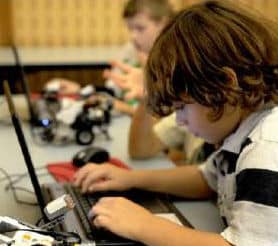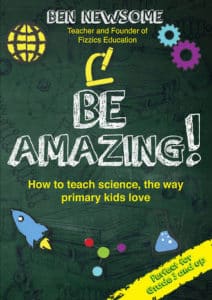So you’ve gone to a massive effort to get together the best materials for a science lesson and your class is completely engaged and thoroughly on task… why not document it? Even better, why not have the students themselves create a blog about their science experiments and subsequent discoveries! Students love to hear from other students. They like to share stories, behind-the-scenes video, funny anecdotes and above all they love to have ownership over what they are doing in the classroom. What better way to do this than to give them the keys to a supervised education blog that not only allows the students to creatively express what has been happening in your classroom but also showcases your own work for other classes to emulate. In short, your everyday science lessons could become a source of inspiration for another school or to your community!

Having students contribute to a shared classroom blog creates unity and shared purpose amongst your students and allows them to become familiar with communicating their thoughts and ideas using technology. Most science experiments are naturally visual and by their very nature have a narrative that can be easily put into a blogging context. The actual process is quite easy and can be highly rewarding for both your students and your school. However, before you implement a classroom science blog there are a few things you’ll need to consider:
- What’s the purpose? Is it to simply to use this as a managed outlet for student expression or is it part of an overall assessment component for your students complete?
- What is your school’s policy on blogging? A quick word with the executive will save you a lot of hassle, although nearly every school is happy to support you when you demonstrate how the student blog will be implemented, the proposed content’s alignment with your curriculum and finally how you will manage the students and public throughout. This leads very nicely towards…
- Child protection issues. Can your student images and recordings be shown publicly on the internet? You need to make sure that written parent permission slips are signed and filed away by the school before you embark on your class first post. When drafting up the parent permission slips be sure to be clear that the purpose of the permission is to cover student images, videos, audio recordings and any other materials that can be used to identify your students. Just like any other parent permission slip, you should run this by your school’s executive so they’re happy with the content and are also aware of what you’re embarking upon.
- Child protection also encompasses how you will manage comments. Sadly there are people on the internet who have nothing better to do than to bring you and your students down. Thankfully you have a couple of easy ways to deal with this; firstly you could simply disable public commenting and control the users by using a password-protected blogging service like EduBlogs (powered by WordPress), Weebly for Education, Wikispaces Classroom, PBWorks or similar.
- How much time do you have to dedicate to the student science blog project? Ideally, the students should be documenting photos & video throughout your planned science experiments which is great as they can be saved on a central file for access during a computing lesson later.
- Finally, is there is a target audience for your student science blog? Is your science classroom blog designed just so students can share the information between the classes in your own school or are you thinking more broadly to include the student’s parents, other schools or the general public?
And that’s it really! Once you’ve addressed the above you’ve now got the framework to quickly throw together a student guide, some science topics for students to focus upon and perhaps even an assessment rubric as well. Like always, what your student’s produce will be a direct result of the science stimulus items in your class, the types of technology you have available as well as your student’s proficiency in conducting science materials and using digital technology. Below are some ideas that you could use as a way of structuring some of your classroom blog articles:
- A blow by blow account of a longitudinal science experiment. By this, I mean the sort of science experiment that requires regular measurements over a series of days or even weeks. The types of science experiments that are well suited to this include crystal growing experiments, plant growth experiments or simply measuring the weather. This type of science blog is effectively like a diary where you publicly record your class experiment results as well as their thoughts.
- A description of how to use a particular science apparatus in your classroom. The science blog article could be about a digital microscope the students have been using, it could be how they’re preparing for an astronomy night or about their preparations to put 3D printing into your Maker lab. Ask students to make their writing piece as informative and interesting as possible as the aim of this is to open a window of the classroom to their world.
- Digital microscopy

- The science blog could also be about a special school science visit, a science fair or a bush walk you took your students on recently. We come across quite a lot of class blogs where teachers and students have taken photos and videos of our science demonstrations and then used them to not only describe them in detail but also to use them as seed for further investigation.
Importantly, the length of the blog doesn’t have to be set in stone. Some days you might find that students can only produce 100 to 200 words and then other days the blog could be double or triple that! As your students get used to writing in their blog you should find that not only does the length of their submissions increase but also the writing quality. In fact, you’ll find the requirement to include variables and fair testing and structuring their experiments using the scientific method should mean that student blogging should also become more structured and coherent. Why not have the blog literally address what you’d expect to read in a science report (aim, method, results etc) and then allow them to write their own thoughts in the discussion? As students’ progress through school they should learn to write a scientific report anyway, the blog could easily become a way of re-purposing this work so that it can be digested by other readers.
Try to aim to include images and video as much as possible as not only does help document your science experiments in your room it also makes the content your students are producing much more engaging and inviting to explore. We love the use of Vine in the science classroom as it forces students not only to carefully think about how to be succinct in 6.5 seconds but if used effectively it also requires students to learn to use video editing software to overlay captions as well. Otherwise, a simple upload to YouTube or Vimeo would be fine too. How do you embed the videos on your blog? You should find a ‘share’ button on the video platform where you can get the code to embed the video on your blog.
Include lots of hyperlinks to information throughout your blog as well as educational content you can find on other websites as well. This is a lesson in itself for students as they will need to learn to be selective with which website they feel most correctly and visually represents their science topic at the appropriate reading age. As much as we love Wikipedia, perhaps it might be worth looking at websites who are renowned authorities in a given area (eg. the World Health Organisation makes complete sense if your students are blogging about medicine!). It’s also worth considering the timing of when to publish your student blog article to coincide with national or global science events too.
Once you are producing regular educational content on a weekly basis and weaving the production into your curriculum as part of your routine you’ll find it get easier and easier. Why not appoint a student as a head blogger each week? This head blogger could be in charge of collating your week’s science activities onto one file folder so every student can easily access the imagery and videos to quickly put together their blog article at the end of the week. Quite a number of schools have included blogs as part of the homework for students to complete which is not a bad way to have students reflect on what has happened in your class as well as show their parents about what they’ve been learning in science lately.
Getting a classroom blog up and running doesn’t have to be onerous. These days most software platforms are very user-friendly and have a large number of resources and forums where you can chat with another user for support and guidance. Once up and running you’ll find that the process is highly rewarding and your classroom blog will become yet another student science engagement tool you can employ. The bottom line; students love it and so will you too!
NEW Primary science teaching book!
“Be Amazing! How to teach science, the way primary kids love”





























Comments